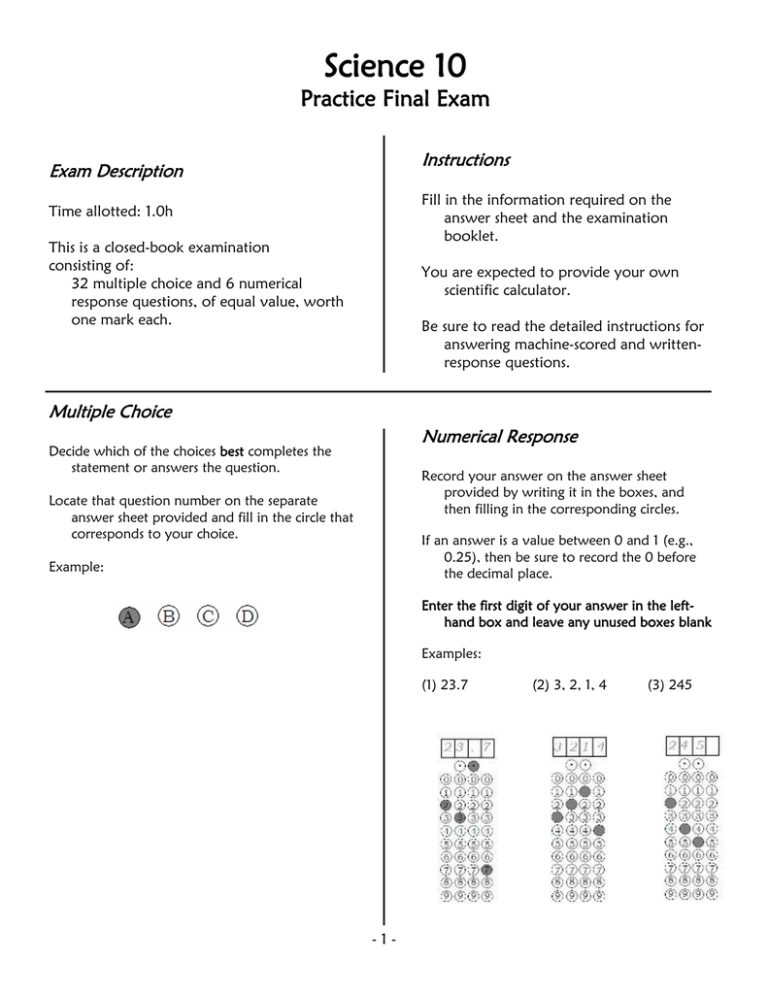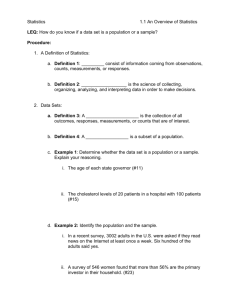File
advertisement

Science 10 Practice Final Exam Instructions Exam Description Fill in the information required on the answer sheet and the examination booklet. Time allotted: 1.0h This is a closed-book examination consisting of: 32 multiple choice and 6 numerical response questions, of equal value, worth one mark each. You are expected to provide your own scientific calculator. Be sure to read the detailed instructions for answering machine-scored and writtenresponse questions. Multiple Choice Numerical Response Decide which of the choices best completes the statement or answers the question. Record your answer on the answer sheet provided by writing it in the boxes, and then filling in the corresponding circles. Locate that question number on the separate answer sheet provided and fill in the circle that corresponds to your choice. If an answer is a value between 0 and 1 (e.g., 0.25), then be sure to record the 0 before the decimal place. Example: Enter the first digit of your answer in the lefthand box and leave any unused boxes blank Examples: (1) 23.7 -1- (2) 3, 2, 1, 4 (3) 245 1. The name of the ionic compound with the chemical formula Na3N(aq) is a. nitric acid. b. trisodium nitrate. c. sodium nitride. d. trisodium mononitride. 2. Which of the following substances would you expect to taste sour? a. KOH(aq) b. H3PO4(aq) c. CH4(g) d. CH3COCH3(aq) 3. The formula for calcium phosphide is: a. Ca3P2(s) b. Ca3P3(s) c. Ca2PO4(s) d. Ca3PO4)2(s) 4. The missing coefficients (in order) from the reaction equation for the combustion of benzene (C6H6(l)) are: C6H6(l) + O2(g) 12 CO2(g) + H2O(g) a. 3, 15, 6 b. 3, 8, 8 c. 2, 15, 6 d. 2, 8, 8 5. An equation for a double replacement reaction is: a. Fe(s) + CuSO4(aq) b. (NH4)2CO3(aq) + Ba(OH)2(aq) c. 2 K(s) + 2 H2O(l) d. C3H8(g) + 5O2(g) 6. Which of the properties listed below are characteristic of an ionic compound? FeSO4(aq) 2NH4OH(aq) 2KOH(aq) 3CO2(g) I – it is malleable II – it is solid at room temperature III – its solution conducts electricity a. b. c. d. I, II and III II and III only I and III only I and II only -2- + + + + Cu(s) BaCO3(s) H2(g) 4H2O(l) 7. In the periodic table, the chemical family that includes helium, argon, and neon is the: a. noble gases. b. halogens. c. alkaline-earth metals. d. alkali metals. 8. What is the mass of 1.50 mol of sucrose? a. 180.16 g b. 270.27 g c. 342.34 g d. 513.51 g 9. As a machine is improved, its efficiency should: a. increase as the amount of waste energy decreases. b. decrease as the amount of waste energy decreases. c. increase as the amount of waste energy increases. d. decrease as the amount of waste energy increases. 10. Jupiter’s acceleration due to gravity is 26.2 m/s2. The amount of potential energy stored in a 300g object 1.75m above Jupiter’s surface would be: a. 5.15 x 103 J b. 13.8 J c. 13.8 x 103 J d. 5.15 J 11. Objects A and B have the same kinetic energy, but object B has three times the speed of object A. The mass of object B must be: a. three times the mass of object A. b. nine times the mass of object A. c. one-third the mass of object A. d. one-ninth the mass of object A. 12. If the height above the ground of an object decreased, the total mechanical energy would: a. increase, because kinetic energy increases. b. decrease, because potential energy decreases. c. increase, because potential energy increases. d. decrease, because kinetic energy decreases. 13. The acceleration of an object in motion is positive when: a. its speed increases, traveling North. b. its speed increases as it falls. c. its speed stays constant, traveling East. d. its speed decreases as it is rolled up a hill. -3- Use the following graph to answer the next two questions: 14. The object with the greatest speed after 2.0s is: a. object 1. b. object 2. c. object 3. d. all three objects have the same speed. Numerical Response 1. The acceleration of object 2 is: Answer: m/s2 (Record your answer, rounded to two significant digits, in the numerical response section of this answer sheet.) 15. A vendor selling hot dogs at a football game carries a 5.0kg tray. Work would be done by the vendor when he: a. stands waiting for money b. walks across the aisle to a customer. c. makes change. d. climbs a flight of stairs. 16. A 0.300 kg arrow is shot directly upwards at a speed of 10.0m/s. What height does the arrow reach? a. 2.0 m b. 5.1 m c. 15 m d. 98 m -4- Numerical Response 2. The list below are some types of energy: (1) potential (2) kinetic (3) thermal (4) electrical (5) chemical (6) nuclear In a coal burning power plant, the energy transfers that occur, in order, are: Answer: _____ _____ _____ _____ (Record your four digit answer in the numerical response section of this answer sheet.) 17. Which process or processes reduce the amount of water in the plant? a. placing a plant in a hypertonic solution b. transpiration c. photosynthesis d. all of the above 18. Which process produces oxygen in leaves? a. phototropism b. photosynthesis c. transpiration d. respiration 19. Guard cells open the stomata because: a. water leaves the cell by evaporation. b. a hormone causes the cells to swell. c. water exits the cell by osmosis. d. their turgor pressure increases. 20. The correct order of these structures from simplest to most complex is: a. cell, system, tissue, organ. b. tissue, system, organ, cell. c. cell, tissue, organ, system. d. system, organ, tissue, cell. 21. Movement of a substance along its concentration gradient with the assistance of a carrier protein is: a. facilitated diffusion. b. active transport. c. osmosis. d. diffusion. 22. Which of the following is true for both plant and animal cells? a. Both have a cell wall. b. Both contain a cytoskeleton. c. Both store energy as glycogen. d. Both contain chlorophyll. -5- 23. The ground tissue of the root: a. carries out photosynthesis. b. stores food and water. c. takes in water and minerals from the soil. d. protects the plant against disease. Numerical Response 3. The field diameter of a microscope on low power, with a 4X objective lens, is 1.20mm. The field diameter on high power, with a 40X objective lens, in micrometres, is Answer: µm (Record your three digit answer in the numerical response section of this answer sheet.) 24. The correct statement about endoplasmic reticulum is: a. smooth endoplasmic reticulum synthesizes proteins. b. rough endoplasmic reticulum synthesizes carbohydrates. c. rough endoplasmic reticulum contains lysosomes. d. the endoplasmic reticulum branches off from the nucleus. Numerical Response 4. Below is a list of steps in the opening of a stoma (1) guard cells become turgid (2) water enters the guard cells by osmosis (3) potassium ions enter the guard cells (4) stomatic opening enlarges The correct sequence of events that cause a stoma to open is: _____, _____, _____, _____ (Record your four digit answer in the numerical response section of this answer sheet.) 25. In the Northern Hemisphere, the day with the most hours of daylight: a. is a solstice. b. in an equinox. c. occurs when the South Pole is most tilted toward the Sun. d. depends on the latitude. 26. The biome characterized by cold temperatures and low levels of precipitation is the: a. grassland. b. desert. c. tundra. d. rainforest. 27. Compared to soil, snow has a: a. higher albedo because it is shiny. b. lower albedo because it is shiny. c. lower albedo because it is dull. d. higher albedo because it is dull. -6- 28. Which of the activities below would give a country emission-reduction credits under the Kyoto Protocol? a. helping a developing country reduce its emissions b. helping another country develop energy-producing industries c. selling another country technology to monitor its emissions d. managing their own old-growth forests 29. The lithosphere is warmed by: a. incoming energy from the sun. b. the gases in the atmosphere. c. the molten material in the Earth’s mantle. d. both (a.) and (c.) Numerical Response 5. A 50.00g mass of water at 25.00oC is heated to 50.000C on a hot plate. How much thermal energy is added to the water as it is heated? Answer: J (Record your four digit answer in the numerical response section of this answer sheet.) 30. If 8.38kJ of thermal energy is added to 100.0g of water, its temperature should rise from 10.0oC to: a. 20.0oC b. 30.0oC c. 83.8oC d. 100oC 31. When 150g of water condenses from steam to liquid water, how much energy is given off? a. 40.7 kJ b. 338 kJ c. 2703 kJ d. 6105 kJ Numerical Response 6. When 5.00g of ice melts, 1.67kJ of thermal energy is absorbed. The experimental heat of fusion of ice is: Answer: kJ/mol (Record your answer, rounded to three significant digits, in the numerical response section of this answer sheet.) -7- Climatograph 1 180 35 25 140 120 15 100 5 80 60 -5 40 -15 20 0 -25 J F M A M J J A S O N D Month Use the following climatographs to answer the next question. 180 35 160 25 140 15 120 100 5 80 -5 60 -15 Temperature (°C) Precipitation (mm) Climatograph 2 40 -25 20 0 -35 J F M A M J J A S O N D Month 35 160 25 140 15 120 100 5 80 -5 60 -15 0 35 160 25 140 15 120 100 5 80 -5 60 -15 40 40 20 180 -25 20 -35 0 -25 -35 J F M A M J J A S O N D J F M A M J J A S O N D Month Month 32. The biome that is best represented by Climatograph 4 is the a. tundra b. desert -8- Temperature (°C) 180 Precipitation (mm) Climatograph 4 Temperature (°C) Precipitation (mm) Climatograph 3 Temperature (°C) Precipitation (mm) 160 c. deciduous forest d. tropical rain forest -9-





